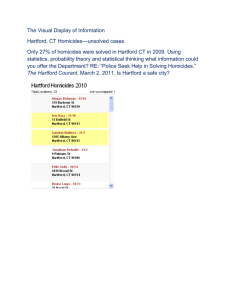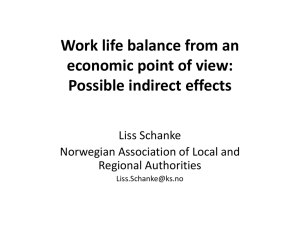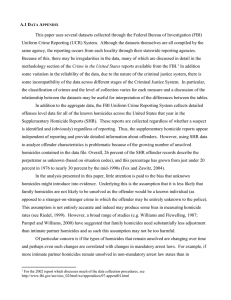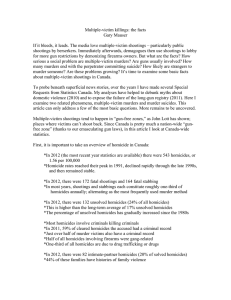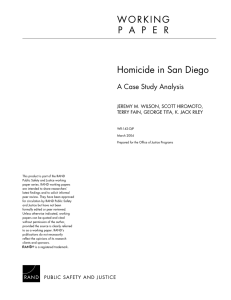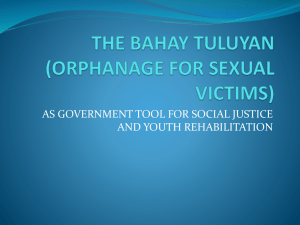Chapter 4 Powerpoint
advertisement
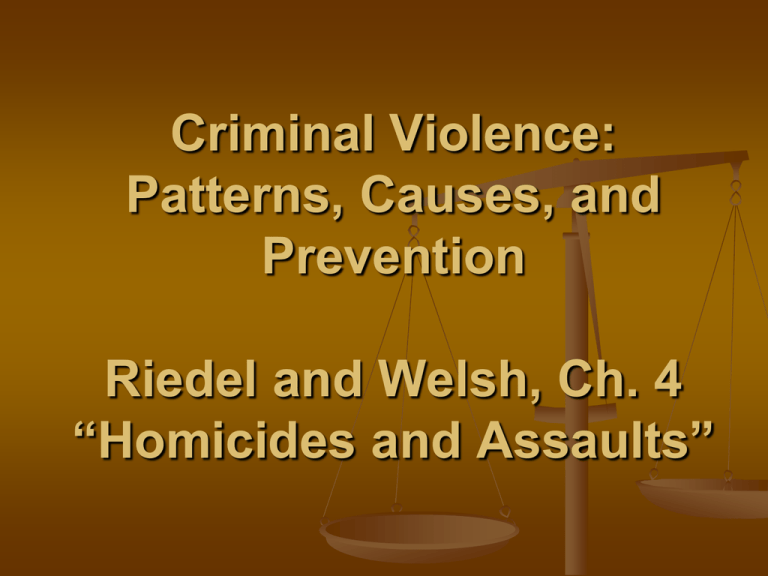
Criminal Violence: Patterns, Causes, and Prevention Riedel and Welsh, Ch. 4 “Homicides and Assaults” OUTLINE Homicides and Assaults in the U.S. Patterns and Trends Explanations Interventions Definitions Murder and Non-negligent Manslaughter (UCR): the “willful (non- negligent) killing of one human being by another.” Aggravated Assault (NCVS): "attack or attempted attack with a weapon, regardless of whether an injury occurred or not, as well as an attack without a weapon when serious injury resulted." Simple Assault: does not involve a weapon; does not result in serious injury to the victim Homicide Patterns (UCR): 2008 VICTIMS Gender: 78.0% of victims were male Race: 47.81% of victims were black, 48.2% white, 2.3% “other” Victim/offender relationship: 9.4% of victims were killed by intimate partners 8.1% of victims were killed by other family members 12.3% were murdered by strangers 26.0% were slain by acquaintances (neighbor, friend, employee, etc.) OFFENDERS Gender: 64.9% of offenders were males. Race: 36.5% of offenders were black, 32.8% were white, and 1.7% were “other” INCIDENTS Firearms: 66.8% of the offenses involved firearms Setting: 28.9% of victims were murdered during arguments 20.6% were killed in conjunction with a felony (rape, robbery, etc.) Circumstances unknown for 35.3% of reported homicides Figure 4.1 Homicide Rates in the United States, 1960-2008 10.5 10 9.5 Homicide Rate per 100,000 9 8.5 8 7.5 7 6.5 6 5.5 5 4.5 1960 1965 1970 1975 1980 Source:Sourcebook of Criminal Justice Statistics. 1985 Year 1990 1995 2000 2005 2010 http://www.albany.edu/sourcebook/pdf/t31062004.pdf. Table 1. Rates of violent crime, by gender, race, Hispanic origin, and age of victim, 2008 Violent Demographic characteristic of victim Population All victimizations per 1,000 persons age 12 or older Rape/sexual assault Robbery All assault Aggravated assault Simple assault Gender Male 0.3^ 2.7 18.3 3.9 14.5 1.3 1.7 14.3 2.8 11.5 204,683,50018.1 30,709,86025.9 13,952,24015.2 0.6 1.9^ 0.9^ 1.6 5.5 3.0^ 15.9 18.5 11.3 3.0 5.2 2.8 12.8 13.3 8.5 2,896,93051.6 1.9^ 6.8 42.9 6.8 36.1 34,506,68016.4 0.6^ 3.4 12.4 3.5 8.9 217,351,75019.7 0.8 2.0 16.9 3.3 13.6 12-15 16-19 20-24 25-34 35-49 50-64 16,414,55042.2 17,280,27037.0 20,547,62037.8 40,649,50023.4 65,123,03016.7 55,116,32010.7 1.6^ 2.2 2.1 0.7 0.8 0.2^ 5.5 4.8 5.4 2.3 1.9 0.8 35.2 30.0 30.3 20.5 14.1 9.7 6.1 5.6 8.7 4.0 2.7 2.0 29.0 24.5 21.5 16.5 11.4 7.7 65 or older 37,111,2403.1 0.2^ 0.2^ 2.7 0.4^ 2.3 Female Race White Black Other race* Two or more races 123,071,02021.3 129,171,51017.3 Hispanic origin Hispanic Non-Hispanic Age Note: Violent crimes measured by the National Crime Victimization Survey include rape, sexual assault, robbery, and aggravated and simple assault. Because the NCVS interviews persons about their victimizations, murder and manslaughter cannot be included. ^Based upon 10 or fewer sample cases. N *Includes American Indians, Alaska Natives, Asians, Native Hawaiians, and other Pacific Islanders. Table 2 Property crime rates, by household income and household size, 2008 (Burglary, Motor Vehicle Theft, and Theft) . Characteristics of household Household income Less than $7,500 $7,500-$14,999 $15,000-$24,999 $25,000-$34,999 $35,000-$49,999 $50,000-$74,999 $75,000 or more Number of persons in household 1 2 or 3 4 or 5 6 or more Number of households Total Victims 4,115,470 6,361,960 204.2 175.0 9,412,930 161.7 9,901,970 13,497,280 14,601,440 24,115,150 150.5 142.7 125.8 133.4 34,561,280 60,022,010 22,868,210 3,689,560 100.3 122.2 197.0 273.9 Explanations Symbolic interaction theory Both homicides & aggravated assaults tend to result from an escalation of interpersonal conflict [see Luckenbill]. Both tend to have similar situational dynamics: Both tend to occur between people who know one another, especially during an argument or fight. Violence is often goal-oriented behavior: "to compel or deter others, to achieve a favorable social identity, and to obtain justice, as defined by the actor." Explanations (cont.) Subcultural theories: values and beliefs that sanction violence as problem-solving behavior within certain groups (e.g., gangs) The subculture of violence suggests that lower- or working-class youths more frequently see violence as a way to solve personal problems. Interventions Q: What explanations have been offered for declines in homicide and aggravated assaults since 1993? 1. 2. 3. 4. 5. 6. 7. Decline in high-risk age group (15-24) Decline in handgun homicide Drug markets stabilized Increase in legitimate and decrease in illegitimate opportunities Increased use of incarceration Decline in partner homicides Violence prevention programs (e.g., mediation) Arrest Clearances Definition: An act is considered cleared when “at least one person is arrested, charged with the commission of an offense, and turned over to the court for prosecution…” (FBI) Arrest clearances for homicides have declined linearly from 92.3% in 1960 to 63.6% in 2008. Why Are Arrest Clearances Important? Without arrest, no further processing of offenders Without arrest, offenders are free to offend again No arrest further traumatizes victim and family Low clearance rates undermine morale of law enforcement Low clearance rates mean less information on offenders for research Arrest Clearances (cont.) Type of homicides cleared Homicides with female victims more likely to be cleared White victim homicides are more likely to be cleared, although the research results are mixed Young homicide victims are more easily cleared Non-gun homicides are cleared more quickly Homicides involving domestic and intimate partner relationships are cleared more readily Explanations and Interventions Explanations Do police investigate all homicides equally diligently or do they exercise discretion by race, gender, age, etc. of victim? Drawing from Donald Black’s theory, Litwin and associates found mixed results Interventions Cold case squads continue the investigation of homicides after the usual amount of time devoted to clearing has passed Vicodq Society provides support to cold case investigations Serial Homicides and Mass Murders Serial homicides: multiple killings by the same person over a period of time, usually months or years Mass murder: single event or several killings in a very brief period -- “spree killing.” Prior to 1980s, inflated estimates resulted from invalid practice of attributing all homicides with “unknown” circumstances to serial killings. FBI Estimates: about 127 serial homicide victims/year, about 10 offenders operating at any one time. Psychological appearance: “extraordinarily ordinary” Fox & Levin: serial killers kill for thrills, sexual satisfaction, or feelings of dominance and control-more “cruel” than “crazy.” Some are sociopaths, but show affection toward family members & friends. Serial Homicides Victims: often vulnerable (e.g., elderly, transients, prostitutes, runaways, hospital patients) people who may not be quickly missed Offenders: Hickey identified 337 male (83%) and 67 female (17%) serial killers responsible for 2,526 homicides between 1800 and 1995. Whites: 80% of all serial killers. Majority tend to operate in one city or even one neighborhood. Trends: Serial homicides may have increased over time. 35% of the killers in sample were identified between 1950 and 1974 45% of the killers were identified between 1975 and 1995 Explanations Little research supports any one cause consistently. Biological: XYY, neurotransmitters, hormonal imbalances Psychological: psychosis, dissociative disorders, personality disorders, psychopathy Sociological: anonymity and normlessness (anomie), child abuse, labeling, lack of social bonds But: huge number of “false positives” (i.e., many normal people have one or more of these characteristics and are not serial killers, or even violent, or even criminals) Interventions Law enforcement approaches include interagency communication, geographic analysis, and profiling (look for patterns in incidents, victims, places). Example: DC snipers
